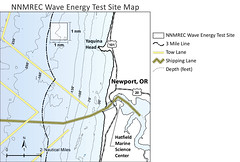 NEWPORT – This Saturday, June 11, is NOAA Day at the Hatfield Marine Science Center, and a great time to learn more about the marine research conducted by the federal government’s Pacific Research Fleet, which is in the process of relocating to Newport.
NEWPORT – This Saturday, June 11, is NOAA Day at the Hatfield Marine Science Center, and a great time to learn more about the marine research conducted by the federal government’s Pacific Research Fleet, which is in the process of relocating to Newport.
The new Newport Marine Operations Center – Pacific will complement the activities of NOAA researchers who have been based at the HMSC for decades. On Saturday, visitors will have opportunities to learn about the scientists who rely on the NOAA ships to conduct their fisheries and oceanographic research as well as the NOAA Corps, whose officers and staff operate the ships and manage the fleet.
Scheduled activities include:
- 11:00am – 11:45am – Dr. Stephen Hammond, Chief Scientist, NOAA Office of Ocean Exploration and Research will present “Exploring the Ocean – New Discoveries”. The short video clips and PowerPoint presentation will include information about coming activities at the cabled observatory offshore at the Axial Volcano.
- 12:00pm – 12:45pm – “Using Long-term Ocean Observations to Forecast Salmon Returns” presented by Dr. Bill Peterson, Senior Scientist, NOAA Fisheries, Northwest Fisheries Science Center
- 1:00pm – 1:30pm -“Giant Pacific Octopus Feeding” presented by Dr. Bill Hanshumaker, Public Marine Education Specialist, Oregon Sea Grant
- 1:30pm – 2:30pm – “The Power of Art and Narrative to Make Fisheries Issues Easier to Understand”. Award winning author/illustrator of ten books, Taylor Morrison, will give a brief presentation about the creation of his latest book A Good Catch. Original paintings, sketchbooks, and storyboards will be on display. Following the presentation Taylor will be signing copies of the book made available for free, courtesy of NOAA.
- 2:30pm – 3:30pm – “Science and Service in the NOAA Fleet”. Learn about the NOAA fleet’s upcoming missions. Presented by NOAA Corps officer Russell G. Haner of the Northwest Fisheries Science Center.





